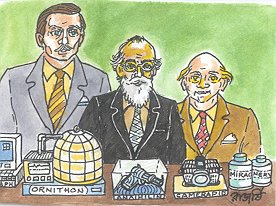
Professor Trilokeshwar Shonku is a fictional scientist and inventor created by Satyajit Ray in a series of Bengali science fiction books of the same name published from 1965. He is the central protagonist of the series. Professor Shonku resides in Giridih. His house contains a laboratory, and he lives with his pet cat, Newton, named after Sir Isaac Newton and his man-servant, Prahlad. He was born in the year of 1912 but his year of death is unknown.
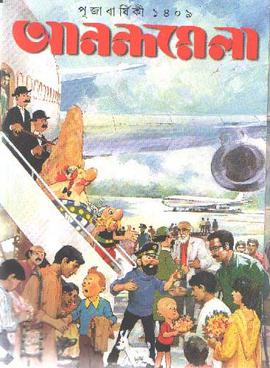
Anandamela, Anondamela, or Anondomela is a children's periodical in the Bengali language published by the ABP Group from Kolkata, India.

Satyajit Ray (1921–1992), a Bengali film director from India, is well known for his contributions to Bengali literature. He created two of the most famous characters in Feluda the sleuth and Professor Shanku the scientist. He wrote several short novels and stories in addition to those based on these two characters. His fiction was targeted mainly at younger readers, though it became popular among children and adults alike.

Sandip Ray is an Indian film director and music director who mainly works in Bengali cinema. He is the only child of the famous Indian director Satyajit Ray and Bijoya Ray.
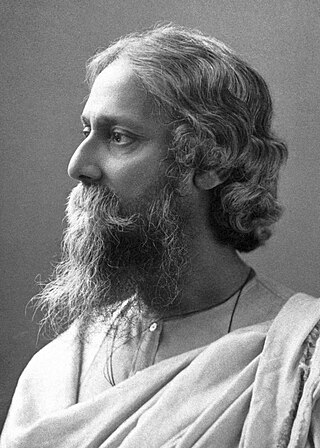
Bengali science fiction is a part of Bengali literature containing science fiction elements. It is called Kalpabigyan or stories of imaginative science, in Bengali literature. The term was first coined by Adrish Bardhan during his editorship years.

Tarini Khuro is a fictional character created by Satyajit Ray. Literally it means respected uncle Tarini. Khuro in old colloquial Bengali means paternal uncle. The full name of Tarini Khuro is Tarini Charan Bandopadhyay. Tarini khuro's adventure stories have a touch of supernatural forces in them. Ray's earlier creations were Feluda and Professor Shonku. This character is central to about fifteen stories written by Ray.

Sandesh is a Bengali children's magazine. It was first published by Upendrakishore Ray in 1913 through his publishing company, M/s U. Ray and Sons. The original partners of the venture were Upendrakishore and his sons Sukumar and Subinoy. Its publication had to be stopped twice. The current phase is the third and longest running one, spanning more than 59 years.
The genre of science fiction has been prevalent in the Indian film industry since the second half of the 20th century. Beginning in 1952, the Tamil film Kaadu was made, which was an Indian-American co-production. The 1963 Tamil film Kalai Arasi, 1965 Telugu film Dorikithe Dongalu, and 1967 Hindi film Chand Par Chadayee also have science fiction in their storyline. The Alien was a science fiction film under production in the late 1960s which was eventually cancelled. The film was being directed by Bengali Indian director Satyajit Ray and produced by Hollywood studio Columbia Pictures. The script was written by Ray in 1967, based on "Bankubabur Bandhu", a Bengali story he had written in 1962 for Sandesh, the Ray family magazine.

Satyajit Ray LH(Bengali pronunciation: [ˈʃotːodʒit ˈrae̯]; 2 May 1921 – 23 April 1992) was an Indian director, screenwriter, documentary filmmaker, author, essayist, lyricist, magazine editor, illustrator, calligrapher, and composer. Widely considered one of the greatest film-makers of all time, Ray is celebrated for works including The Apu Trilogy (1955–1959), The Music Room (1958), The Big City (1963) and Charulata (1964) and the Goopy–Bagha trilogy.
Professor Shonku is a collection of nine science fiction short stories by Satyajit Ray featuring the fictional scientist-inventor Professor Shonku. The collection was first published in 1965 by Calcutta publisher NewScript Publications.
"Byomjatrir Diary" is the first story of the Professor Shonku series created by Indian writer and filmmaker Satyajit Ray. It was first published in Sandesh, edited by Ray himself, in 1961. Ray included this story in his first collection of Shonku stories, Professor Shonku, in 1965. The story follows Professor Trilokeshwar Shonku, a Bengali scientist and inventor, who travelled to Mars and after being attacked by the Martians, fled to a planet named Tafa, where the inhabitants welcomed him and made him a citizen of their planet.

Punashcha Professor Shonku is a Professor Shonku series book written by Satyajit Ray and published by Ananda Publishers in 1993. Ray wrote these stories about Professor Shanku for Bengali magazines Sandesh and Anandamela. This book is a collection of five Shanku stories.
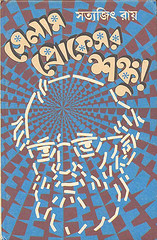
Selam Professor Shonku is a Professor Shonku series book written by Satyajit Ray and published by Ananda Publishers in 1995. Ray wrote these stories about Professor Shanku for Bengali magazines Sandesh and Anandamela. This book is a collection of seven Shonku stories.
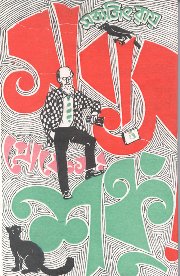
Shabash Professor Shonku is a Professor Shonku series book written by Satyajit Ray and published by Ananda Publishers in 1974. Ray wrote the stories about Professor Shanku in Bengali magazines Sandesh and Anandamela. This book is a collection of seven Shonku stories.

Professor Shonkur Kandokarkhana is a Professor Shonku series book written by Satyajit Ray and published by Ananda Publishers in 1970. Ray wrote the stories about Professor Shanku for the Bengali magazines Sandesh and Anandamela. This book is a collection of seven Shonku stories.
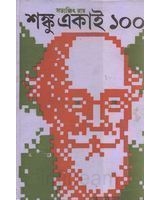
Shonku Ekai Aksho is a Professor Shonku series book written by Satyajit Ray and published by Ananda Publishers in 1983. Ray wrote the stories about Professor Shanku for Bengali magazines Sandesh and Anandamela. This book is a collection of four Shonku stories.

Swayang Professor Shonku is a Professor Shonku series book written by Satyajit Ray and published by Ananda Publishers in 1980. Ray wrote the stories about Professor Shanku in Bengali magazines Sandesh and Anandamela. This book is a collection of three Shonku stories.
The Mystery of the Pink Pearl is a Bengali detective story written by Satyajit Ray. Feluda is the protagonist of the story. It was first published in Sandesh (magazine), 1989. The story ranks 31st in the Feluda series.

Professor Shonku O El Dorado is a Bengali science fiction adventure drama film directed by Sandip Ray based on Nakur Babu O El Dorado, a story of Satyajit Ray. Dhritiman Chatterjee portrayed the protagonist character of Professor Shonku. The film released theatrically on 20 December 2019.















